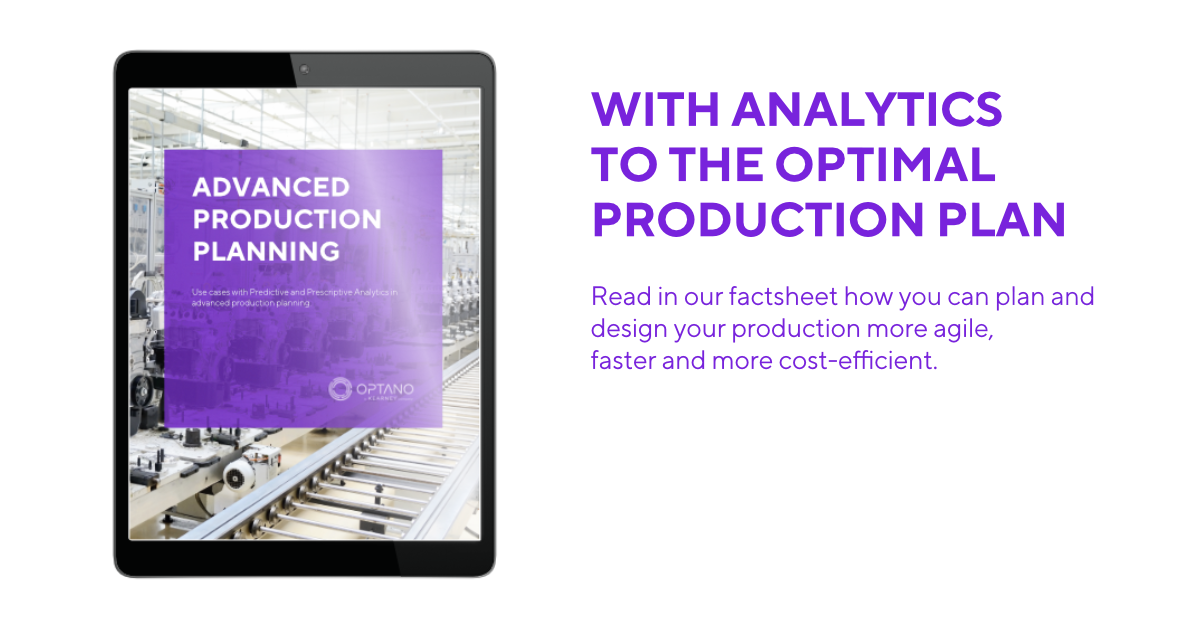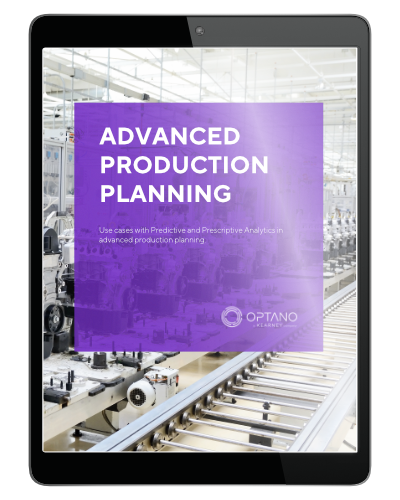Experience next level
production planning.n
Who doesn’t have them in their basement or in the attic – the boxes full of DVDs, CDs, audio tapes or VHS cassettes? Whenever you move house, they fall into your hands and you start fondly reminiscing about times gone by. The problem is, you can hardly use these items anymore. So they go back into the box until the next time you stumble across them or load them onto the removal truck. Back in their day, these items stood for progress in technology. These days, however, they have become so obsolete that a lot of people don’t even have the appliances on which to play them. Today, they merely serve as nostalgic remnants of the past. The life cycle of products is becoming increasingly shorter and they are being superseded by other, better versions. This does not only apply to technical devices, it’s the same in all economic sectors.
Customers’ demands for more individual products means that their manufacture is becoming increasingly more complex; not only do more different parts have to be manufactured, batch sizes are also decreasing and threatening to turn production into a costly affair. n top of this, the global market situation is making it difficult for many manufacturers. Thanks to customs, supply chain disruptions and the general scarcity of many raw materials, production planning is becoming ever more complex and planners have to respond to unforeseen events far more often.
Production planning with spreadsheets - another one for the attic
While production planning with Excel or similar products was once the epitome of enormous technical progress, today it is no longer in fashion. Of course it does the job – just like audio tapes can still be used to record music – but it lags far behind current technical possibilities as far as quality and quantity is concerned. Here we would like to take a look at its weak points which can quite easily be transformed into advantages using mathematical optimization.
Not up to the challenges
The main feature of software for spreadsheet calculations is, of course, calculating. And this is what it is really good at! However, when planning with large data volumes and many cross-dependencies, when creating time-critical new plans and making forecasts, it quickly becomes evident that it is simply not up to the job at hand. It reaches its limits all too fast and lags so far behind the possibilities which planning software would provide.
A high rate of errors
We may not want to admit it, but we humans are the largest source of errors in many areas. The more manual work that is required in production planning, the greater the probability that errors will occur. And even if there are just one or two inaccuracies in the data, these affect the entire manufacturing chain and can have major impacts on the overall result.
High personnel costs
Production planning in a spreadsheet is extremely time-consuming and involves a lot of personnel. Many processes which actually should and could be fully-automated, have to be controlled manually which, in turn, increases the rate of errors. Surely the skills of well-trained planners could be put to better use than in performing repetitive tasks?
What can be gained from good production planning?
If you make good use of all the possibilities that production planning has to offer, you can simultaneously focus on a lot of objectives and improve them. These are partly company-wide objectives but also specific ones for production planning.
High profit
Cost-efficiency and consequently the share of the profit are naturally extremely important aspects in production planning. With these values you can analyze whether and where processes can be structured more efficiently in order to save money and increase your profit.
Putting resources to good use
It goes without saying that production should deploy the resources at its disposal as well as possible. Using this indicator, you can analyze whether certain resources form a bottleneck in production or whether you still have capacity for further orders.
High throughput
Which quantity of a product can you produce in which unit of time? Your throughput can provide the answer to this question. Of course you would like to manufacture as many parts per unit of time as you can. This can be achieved by identifying the bottlenecks in your production. A production line can only be as fast as its slowest element. Finding this and improving it can increase your throughput overall.
Fewer rejects
The more products you have which fail to pass quality control, the more expensive is the manufacture of flawless products per unit. Furthermore, processing the rejects costs time and money which additionally sends manufacturing costs through the roof without any turnover being generated. By reducing the number of rejects, you not only save on raw materials but also increase the throughput of the manufacturing chain.
Fewer delays
Sometimes it is simply not possible to manufacture products within schedule. However, you can keep this value as small as possible with smart production planning. What’s more, through transparency in the production process, possible delays are identified more quickly and you can initiate counter-measures in good time.
Low set-up times
Changeovers often mean a lot of time is lost for actual production. Here, the small batch sizes mentioned at the beginning become particularly evident. If you take this into account at the planning stage, you can minimize your set-up times and thus make more time for profitable production.
There are, however, aspects of production planning which are more difficult to quantify. Yet these are by no means less relevant:
Resilience
If a delivery cannot be met or a machine breaks down at short notice then you need a new plan for the new situation – fast. At best you will have considered this sort of thing already at the planning stage so that as few changes as possible need to be made in the event of any disruption. The ability to respond to minor or even major disruptions was one of the crucial success factors of resilient manufacturing companies, particularly at the onset of the Corona pandemic.
Flexibility
It is not just negative disruptions such as breakdowns which can cause havoc to your production planning. Rescheduling orders or bringing forward urgent orders can lead to new plans at short notice.
Data-controlled
You will get better planning results the more up-to-date and conclusive the data on the basis of which your planning is conducted. The data of the entire production process must therefore be collected, made available and evaluated as fast as possible.
More interesting articles
Next-level production planning
All of these objectives can be pursued by deploying the right tool easily and efficiently. To do this, a mathematical model containing all your company’s relevant information for your production planning is first of all necessary. This means that all the data on production processes, machine occupancy, set-up times, personnel requirements, delivery dates, storage, etc has to be transferred into a model on which the system can perform the optimization. In this model, the objectives you want to achieve will also be defined. You can determine yourself how these objectives should be prioritized. Is it more important to observe delivery dates or have as small a warehouse as possible? Such considerations as these can also be implemented using the model and mathematical optimization. Based on this model, two different approaches can be applied: Predictive analytics and prescriptive analytics. Two highly important questions for production planning can be answered using these methods: What will (probably) happen in the future and which decisions must we make in order to achieve an objective?
Predictive Analytics
For efficient production planning you always have to consider future developments. The more accurate the forecasts are, the better suited your production plans are to the situation. Predictive analytics can make accurate forecasts for the future by analyzing historic data with machine learning. For this method to work properly, you need to have as much data as possible. This must be collected, prepared and then placed at the system’s disposal. As soon as this data infrastructure has been established, however, all of your target parameters can be taken to the next level.
Prescriptive Analytics
Prescriptive Analytics concerns itself with the question: which decisions must be made to achieve a certain objective? If, for example, the production of a manufactured product is to be increased by a certain percentage – since forecasts indicate that this will be necessary to meet future demand – this can be achieved by various means. Depending on the initial situation and production requirements, it may be sufficient to buy another machine. But an entire production line or another site may also be necessary or more efficient. Prescriptive Analytics calculates the best of all possibilities to achieve the desired objective.
Particularly effective when together
Both methods are especially effective if they are deployed together. In this way you get the very best out of your production planning. Every technology has its moment. With an optimization platform such as OPTANO, which deploys mathematical optimization, you can make use of all the possibilities available to enhance the quality of your plans and ensure that your production planning is always up-to-date. OPTANO provides you with a sound basis on which to make decisions, enabling you to get the best results for your planning challenges and making all your planning processes efficient, fast and flexible.
If you would like to learn more about how mathematical optimization methods can enrich your production planning and what other benefits they provide, then why not download our factsheet Modern Production Planning
Please also feel free to contact us directly. Dr. Sven Flake is at hand to answer any questions you may have about optimal production planning.
And what about the items in the attic?
Everything has its moment in time. And sometimes the things we have in the attic are now only there to make us smile fondly when they evoke cherished memories of the past. And even if this wasn’t their original purpose, it’s better that way. So,let’s close the box and put it back up in the attic.
Do you already know our factsheet on the topic?

In our factsheet Advanced Production Planning we present some of the use cases of Predictive and Prescriptive Analytics in modern production planning which you can download here.
To obtain our factsheet, all you need to do is enter your contact details in the space below. A pop-up window will then open to download the whitepaper. Please note that by providing us with your email address, you agree that we may contact you on this topic. You may revoke this agreement at any time by contacting privacy@optano.com.







